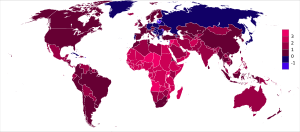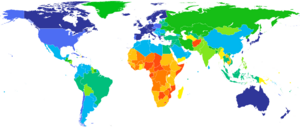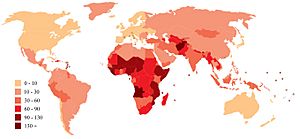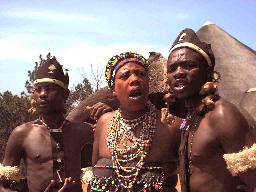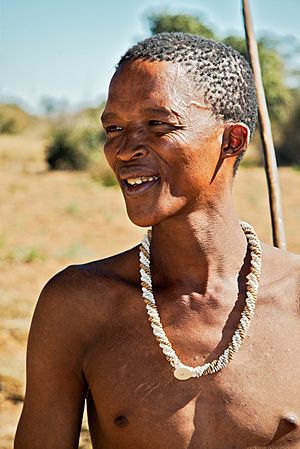Demographics of Africa facts for kids
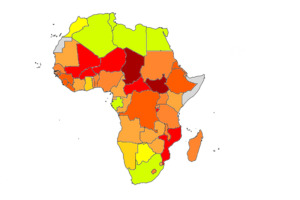
| Map of Africa indicating Human Development Index (2021). | ||
|
The population of Africa has grown very quickly over the last 100 years. This means there are many young people, a situation called a "youth bulge." In some African countries, people do not live as long as in other parts of the world. In 2020, Africa's population was over 1.3 billion. It is growing by more than 2.5% each year. In Sub-Saharan Africa, each woman has about 4.7 children, which is the highest rate in the world. The country with the most people in Africa is Nigeria, with over 206 million people in 2020.
Contents
Africa's Growing Population
Africa's population has changed a lot over time. Around the year 0 AD, Africa had about 16.5 million people. By 1950, this number grew to 228 million. In 2018, it reached 1.321 billion. Experts think Africa's population could reach nearly 4 billion by 2100.
Africa's share of the world's population has also grown. In the year 0 AD, Africa had about 7.1% of the world's people. By 2020, this share increased to 18.2%. It is expected to be almost 38% by 2100.
Population Changes Over Time
The graphs below show how Africa's population has changed from 1950 to 2021.
This graph shows how Africa's population has steadily increased from 1950 to 2021.
This graph shows the "natural change" in population, which is the difference between birth rates and death rates. It shows that Africa's population has been growing naturally over the years.
This graph illustrates the decrease in infant mortality (babies dying before age one) in Africa. This decline is a major reason for population growth.
This graph shows the Total fertility rate (TFR), which is the average number of children a woman has. While it has slowly decreased, it remains high, contributing to population growth.
Africa's population was 177 million in 1950. By 2020, it had grown more than seven times to over 1.341 billion. This growth is happening very fast. Unlike most of the world, Africa still has a very young population that is growing quickly.
In 2019, Africa had about 1.3 billion people, which was 16% of the world's population. The United Nations thinks Africa's population could reach 2.49 billion by 2050. By 2100, it might be 4.28 billion. This means that by 2050, about 37% of all babies born in the world could be in Africa.
Africa's population first went over one billion in 2009. It took only 27 years for the population to double. Experts believe it will reach 2 billion by 2038.
Most of this growth is expected in Sub-Saharan Africa. This region might account for more than half of the world's population increase by 2050.
Why Africa's Population is Growing So Fast
The main reasons for this rapid growth are fewer babies dying (lower infant mortality) and people living longer (higher life expectancy). However, the number of children women have (the fertility rate) has not dropped as much. Things like wealth, education, and women working outside the home can help lower birth rates.
This fast population growth can make it hard for countries to build enough schools, hospitals, and other important services. It can also slow down economic development. Some countries, like Kenya and Zambia, are starting programs to help families plan how many children they have.
The fastest growth is happening in East Africa, Middle Africa, and West Africa. These regions are expected to have five times more people by the end of the 21st century. Middle Africa might see its population grow by 681%. For example, the Democratic Republic of the Congo could go from 47 million people in 2000 to 362 million in 2100. Growth is slower in Southern Africa and North Africa.
Here is a table showing population estimates by region:
| 2000 | 2050 | 2100 | |
| Eastern Africa | 0.26 | 0.85 (+227%, +1.8% p.a.) | 1.45 (+458%, +0.6% p.a.) |
| Middle Africa | 0.096 | 0.38 (+296%, +2.1% p.a.) | 0.75 (+681%, +0.8% p.a.) |
| North Africa | 0.17 | 0.37 (+118%, +1.1% p.a.) | 0.50 (+194%, +0.3% p.a.) |
| Southern Africa | 0.051 | 0.087 (+70%, +0.6% p.a.) | 0.094 (+82%, -0.1% p.a.) |
| West Africa | 0.23 | 0.80 (+248%, +2.0% p.a.) | 1.48 (+543%, +0.7% p.a.) |
| Africa | 0.81 | 2.49 (+207%, +1.7% p.a.) | 4.28 (+428%, +0.6% p.a.) |
| World | 6.14 | 9.73 (+58%, +0.5% p.a.) | 10.88 (+77%, +0.0% p.a.) |
Births in Africa
In 2019, all countries in Sub-Saharan Africa had high birth rates. This means that more babies were being born than needed to replace the parents. This region accounted for over a quarter of all babies born worldwide.
Health in Africa
Improving Healthcare
In 1987, UNICEF and the World Health Organization (WHO) started the Bamako Initiative. This plan aimed to make important medicines more available in Africa. It also wanted to improve basic healthcare for everyone. This led to better access to health services and more efficient care. Over time, the plan grew to improve the quality of health services and how health systems are managed.
Main Health Challenges
Sub-Saharan Africa faces many health challenges, including both infectious diseases and long-term health conditions.
Diabetes
Type 2 diabetes is a big problem in Sub-Saharan Africa. Many people have diabetes but do not know it. This puts them at risk for serious health issues and can lead to more deaths.
HIV/AIDS
In 2011, about 69% of all people living with HIV/AIDS worldwide were in Sub-Saharan Africa. Many efforts have been made to teach people about HIV/AIDS. By 2012, seven times more people with HIV in Africa were getting treatment than in 2005. The number of deaths from AIDS and new HIV infections has also gone down significantly.
Malaria
Malaria is a common illness in Sub-Saharan Africa. Most malaria cases and deaths around the world happen in this region.
Maternal and Infant Health
More than half of all maternal deaths (deaths of mothers during or after childbirth) happen in Sub-Saharan Africa. However, there has been progress, and these death rates have been cut by about half in many countries since 1990.
Sub-Saharan Africa also accounts for about 45% of all infant and child deaths globally. Studies show that when mothers have more education, their babies are more likely to survive. Also, children in rural areas are more likely to die than those in cities.
Other Health Issues
- Measles: Regular vaccinations are helping to prevent measles outbreaks.
- Neglected Tropical Diseases: Diseases like hookworm infection affect about 500 million people in Sub-Saharan Africa.
- Non-Communicable Diseases: These are long-term illnesses like diabetes, hypertension (high blood pressure), cancer, and heart disease. In some African countries, the death rates from these diseases are higher than in richer countries. Better health data and studies can help improve understanding and healthcare plans.
- Onchocerciasis: Also known as "river blindness," this disease is common in parts of Africa. More than 99% of people affected by it worldwide live in 31 African countries. A program called APOC was started in 1995 to control this disease.
- Tuberculosis: Tuberculosis (TB) is a major cause of illness and death worldwide, especially in African areas where many people also have HIV.
Healthcare Systems
Healthcare systems are different in each African country. In Ghana, the government provides most healthcare services. There are different levels of care, from small health posts in rural areas to large hospitals. These services are paid for by the government, loans, and donations.
There is a shortage of healthcare workers in Sub-Saharan Africa. Many health workers move to other parts of the world, like the United States and the United Kingdom. This makes it harder for health systems in Africa to work well.
More than 85% of people in Africa use traditional medicine. This is often because modern medical care and medicines can be expensive. The Organisation of African Unity (OAU) has encouraged African countries to include traditional medicine in their healthcare systems. Leaders are thinking about how traditional and modern medicine can work together to improve health for everyone.
-
Life expectancy has fallen drastically in Southern Africa as a result of HIV/AIDS.
People and Cultures
Africa is home to many different groups of people, each with their own unique cultures and languages.
Ethnic Groups
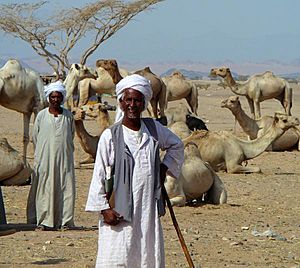
- Southern, Central, and Southeast Africa: Most people here speak Bantu languages. The Bantu were farmers who spread across much of Africa from West Africa. You can also find Nilotic groups in South Sudan and East Africa, and the mixed Swahili people along the coast. A few indigenous groups, like the San and Pygmy peoples, live in southern and central Africa. The San are the original people of southern Africa, and Pygmies are the original people of Central Africa.
- West Africa: People here mostly speak Niger–Congo languages. Some of the largest groups include the Yoruba, Igbo, Fulani, Akan, and Wolof. Other groups like the Hausa and Kanuri are also found.
- North Africa: The main groups are Berbers in the northwest, and Egyptians and Libyans in the northeast. The Arabic language and Islam were brought to this region by Muslim settlers in the 7th century. Over time, many people started speaking Arabic. Berber-speaking people still live in Morocco and Algeria, and in smaller numbers in Tunisia and Libya. The Tuareg are nomadic people who live in the Sahara Desert.
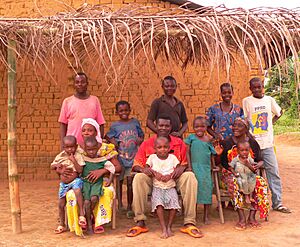
- Horn of Africa: Groups like the Amhara and Tigrayans in Ethiopia and Eritrea speak languages from the Semitic family. The Oromo and Somali speak languages from the Cushitic family.
- European and Asian Descendants: Before the 1960s and 1970s, many Europeans lived in Africa. After countries gained independence, many moved away. However, people of European descent still live in countries like South Africa, Zimbabwe, Namibia, and Réunion. The largest groups are the Boers (also called Afrikaners), people of British descent, and Coloureds (people of mixed ancestry).
Many people from the Indian subcontinent also moved to British colonies in Africa. Large Indian communities are found in South Africa, Kenya, and Tanzania. The Malagasy people of Madagascar have mixed origins, including Austronesian people and native African people. In recent times, people from Latin America and Asia (like Lebanese and Chinese) have also moved to African cities.
Languages
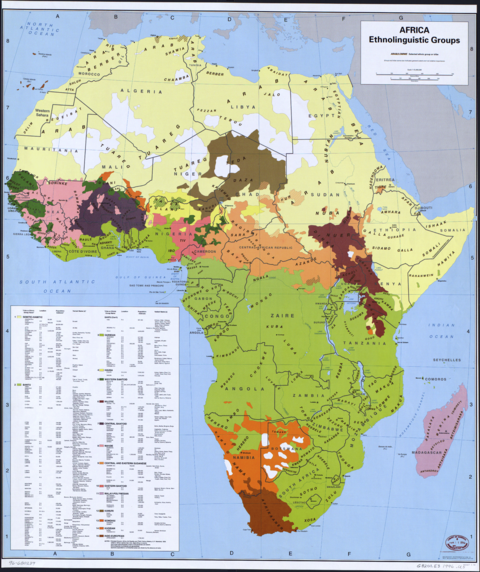
Afroasiatic
Hamitic (Berber, Cushitic) + Semitic (Ethiopian, Arabic)
Hausa (Chadic)
Niger–Congo
Bantu
"Guinean" (Volta-Niger, Kwa, Kru)
"Western Bantoid" (Atlantic)
"Central Bantoid" (Gur, Senufo)
"Eastern Bantoid" (Southern Bantoid)
Mande
Nilo-Saharan (unity debated)
Nilotic
Central Sudanic, Eastern Sudanic (besides Nilotic)
Kanuri
Songhai
other
Khoi-San (unity doubtful; Khoikhoi, San, Sandawe + Hadza)
Malayo-Polynesian (Malagasy)
Indo-European (Afrikaaner)
Africa has a huge number of languages, estimated to be between 1,250 and over 3,000. For example, Nigeria alone has more than 500 languages!
There are three main language families native to Africa:
- Niger–Congo languages: This is the largest family, found in West, Central, Southeast, and Southern Africa. It includes the Bantu languages, which are spoken by about half of all Niger–Congo speakers.
- Nilo-Saharan languages: These are spoken from Tanzania to Sudan and from Chad to Mali.
- Khoisan languages: These are mostly endangered languages with unique "click" sounds, found mainly in the Kalahari Desert.
The Afroasiatic languages are also important. They are spoken in North Africa, the Horn of Africa, and parts of the Sahel.
Languages from other parts of the world have also come to Africa:
- Austronesian languages: Spoken in Madagascar.
- Indo-European languages: Like Afrikaans, English, and German, spoken in South Africa and Namibia. These were often used as common languages in former European colonies.
Many languages are used for communication between different ethnic groups. Arabic, Somali, Berber, Amharic, Oromo, Igbo, Swahili, Hausa, Manding, Fulani, and Yoruba are each spoken by tens of millions of people.
Religion
Africa is home to many different religions, including Traditional African religions, Christianity, and Islam.
See also



